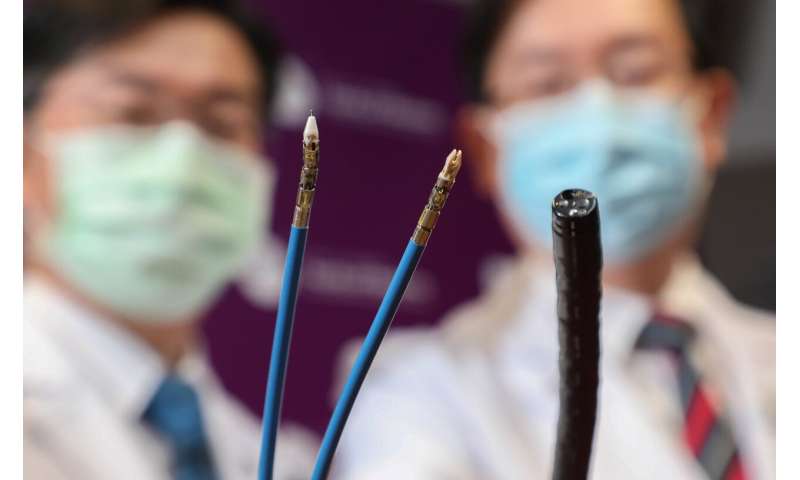
Compared to minimally invasive surgery, endoscopic submucosal dissection (ESD) represents an advanced, less-invasive endoscopic treatment for early gastrointestinal cancer. ESD has significant advantages as an organ preservation surgical treatment, but it is technically challenging with substantial risk of perforation and bleeding.
The Faculty of Medicine at The Chinese University of Hong Kong (CU Medicine) has been collaborating with researchers from Singapore since 2010 to develop a flexible endoscopic robotic system. This novel system was specifically designed to enhance the safety and efficacy of ESD for the treatment of gastrointestinal cancer. Using the first prototype flexible endoscopic robot, our team at CU Medicine successfully performed ESD for treatment of early gastric cancer in 2011. The flexible endoscopic robot is now further redesigned and developed for performing ESD in the colorectum—namely, The EndoMaster EASE (Endoluminal Access Surgical Efficacy) System. CU Medicine led the world’s first clinical trial on robotic colorectal ESD using the EndoMaster EASE System, which commenced in May this year and has demonstrated satisfactory outcomes thus far. Researchers believe this innovative technology will enhance advanced endoscopic resection and benefit more patients with early colorectal cancer who will require ESD treatment.
Growing demand for ESD as more early-stage colorectal cancer patients discovered
Colorectal cancer is the most common cancer in Hong Kong as well as the second-leading cause of cancer-associated death. Management depends on cancer stages, and for patients in the early stages, surgery or endoscopic resection are the two main treatment options. As the government of the Hong Kong SAR has already implemented a population-based colorectal cancer screening program, more patients with colorectal cancer will be diagnosed at an early stage which is amenable to treatment by ESD.
Professor Simon Siu Man NG, professor of the Division of Colorectal Surgery, Department of Surgery at CU Medicine, said, “Open or laparoscopic resections are the conventional surgical treatment for colorectal cancer whereas endoscopic treatment including endoscopic mucosal resection and ESD are less invasive procedures to remove early-stage cancer. ESD enables en-bloc resection of lesions in-situ or those located at the submucosa with lower recurrence. However, this procedure takes a longer time and has a relatively higher risk of perforation if performed by inexperienced endoscopists. There was an urgent need to refine the technology as we have been seeing an increasing demand from the emerging number of early-stage cancer patients around the world discovered under universal screening programs. In Hong Kong, over 60% of confirmed cases under the community colorectal screening program were at an early stage of cancer.”
In 2019, more than 150 patients received colorectal ESD for treatment of early colorectal cancer and neoplasms at the Endoscopy Center of Prince of Wales Hospital.
Robotic ESD mitigates technical difficulties commonly encountered in interventional endoscopy
One of the major difficulties in performing ESD is the lack of tissue retraction during submucosal dissection. Most operative time was spent in maintaining a good view of the submucosal plane while moving the endoscope with the ESD instruments for dissection. The design of the traditional endoscope with the attached dissection knife allows only a single degree of movement, which makes ESD difficult to learn and perform.
The recently developed second-generation flexible endoscopic robotic platform consists of an independently designed flexible platform with an endoscopic imaging system, and allows the passage of two minute robotic arms to achieve tissue retraction and dissection. The Chinese University of Hong Kong led the performance of the world’s first robotic ESD using the EndoMaster EASE robotic System for treatment of early colorectal cancer in May this year in Hong Kong.
Professor Philip Wai Yan CHIU, director of the CUHK Jockey Club Minimally Invasive Surgical Skills Center (MISSC), said, “Our previous pre-clinical and clinical studies confirmed that the robotic endoscopic platform can enhance both the safety and efficacy of ESD in stomach and esophagus. Performing ESD in the colorectum signifies a different level of technical challenge because of its long and winding shape, as well as the thin colonic wall that poses a higher risk of perforation. The EndoMaster EASE System allows tissue retraction with excellent visualization to enhance safety of submucosal dissection. At present, six patients have been successfully treated by colorectal ESD using the EndoMaster EASE System. There was no case of perforation and the patients were able to resume a normal diet and were discharged one day and two days after the procedure respectively. From our initial observation, the flexible endoscopic robotic system is a very promising armamentarium for performing ESD and treating early-stage colorectal cancer. Our clinical trial is still currently underway and we will continue to enroll suitable patients to participate.”
Source: Read Full Article